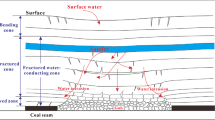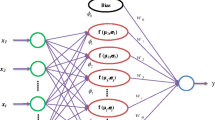Abstract
The movement and failure of overlying strata induced by underground coal mining cause “three zones,” including the caving zone, the water-conductive fractured zone, and the sagging zone from the bottom up. For knowledge about the height of the water-conductive fractured zone, there has been no empirical or theoretical formulae for thick coal seam using fully mechanized longwall mining with sublevel caving. This paper presents a methodology of determining the height of the water-conductive fractured zone based on the radial basis function neural networks (RBFNN) model in MATLAB software. Before modeling, the relationship between the height of the water-conductive fractured zone and mining thickness, the lithologic character of the overburden and its composite structures, and workface parameters was studied. After that, 32 and 7 measured data were used as training and testing samples, respectively. It has been found that the average relative error is 6% and the maximum relative error is 10% for 7 test samples by comparing actual results with predicted results. The model was applied to the no. 31503 workface in the Gaozhuang coal mine for safety evaluation. The predicted value is 59.6 m, and the measured value is 55.9 m. The RBF-based model shows much better performance than empirical formulae in the Regulations for Coal Mining and Coal Pillar Design under Buildings, Water-bodies, Railways and Main Shafts for the prediction of the height of the water-conductive fractured zone for fully mechanized mining with sublevel caving.










Similar content being viewed by others
References
Chen PP (2008) Forecasting of destroyed height of overlying rock with the top coal caving based on ANN. Journal of Coal Science & Engineering 14(2):190–194
Chen RH, Bai HB, Feng MM (2006) Determination of the height of water flowing fractured zone in overburden strata above fully mechanized top coal caving face. Journal of Mining & Safety Engineering 23(2):221–223
Chen PP, Liu HQ, Zhu ZX, Yan Y (2005) Height forecast of water conductive zone with top coal caving based on artificial neural network. J China Coal Soc 30(4):38–442
Gan ZC, Zhang HX, Liu HQ (2006) Application of EH-4 electro-conductibility imaging system in the detection of “two-zones” height. Coal Mining Technology 11(3):14–18
Gao YF, Qu ZJ, Xing F, Qu GL, Li L (2009) Observation of height of excavating face H2106 in Longkoubeizao Mine under sea. Coal Geology and Exploration 37(6):35–38
Hu XJ, Li WP, Cao DT, Liu MC (2012) Index of multiple factors and expected height of fully mechanized water flowing fractured zone. J China Coal Soc 37(4):613–618
Jia HG, Cao QG, Zhang GB, Yu XW, Liu GJ (2015) Failure features of overlying strata in conditions of fully-mechanized caving mining under nearly thick unconsolidated aquifer and safety mining analysis. Safety in Coal Mines 46(8):195–198
Liu TQ (1995) Influence of mining activities on mine rockmass and control engineering. J China Coal Soc 20(1):1–5
Liu WT, Song CW, Ma YC, Kong LZ (2000) Detection technology for damage area of rock in the down hole. Coal Science and Technology 28(6):14–18
Liu WT, Wu Q, Li XZ, Chen DY (2005) Measurement and simulation of damage height of overburden rock. Coal Mine Modernization 5:29–31
Liu G, Zhang HX, Liu ZG, Zou YP, Guo AG, Cui F (2013) Observation and simulation research on development features of overlying strata failure in conditions of fully-mechanized top-coal caving mining under river. J China Coal Soc 38(6):987–993
Ma YJ, Wu Q, Zhang ZY, Hong YQ, Guo LW, Tian HS, Zhang LG (2008) Research on prediction of water conductive fissure height in roof of coal mining seam. Coal Science and Technology 36(5):59–62
Miao XX, Cui XM, Wang JA, Xu JL (2011) The height of fractured water-conducting zone in undermined rock strata. Eng Geol 120:32–39
Shi LQ, Xin HQ, Zhai PH, Li SC, Liu TB, Yan Y, Wei WX (2012) Calculating the height of water flowing fracture zone in deep mining. J China Univ Min Technol 41(1):37–41
State Bureau of Coal Industry (2000) Regulations for coal mining and coal pillar design under buildings, water-bodies, railways and main shafts. China Coal Industry Publishing House, Beijing
Wang LG, Wang ZS, Huang JH, Zhou DL (2012) Prediction on the height of water-flowing fractured zone for shallow seam covered with thin bedrock and thick windblown sands. Journal of Mining & Safety Engineering 29(5):607–612
Wu X, Wang XG, Duan QW, Yu QC, Yang J, Sun YD (2008) Numerical modeling about developing high of water flowing fractured zone. J China Coal Soc 33(6):609–612
Xu YC, Li JC, Liu SQ, Zhou L (2011) Calculation formula of “two-zone” height of overlying strata and its adaptability analysis. Coal Mining 16(2):4–7 11
Xu ZM, Sun YJ, Dong QH, Zhang GW, Li S (2010) Predicting the height of water-flow fractured zone during coal mining under the Xiaolangdi Reservoir. Min Sci Technol 20:434–438
Xu JL, Zhu WB, Wang XZ (2012) New method to predict the height of fractured water-conducting zone by location of key strata. J China Coal Soc 37(5):762–769
Yang GY, Chen C, Gao SL, Feng B (2015) Study on the height of water flowing fractured zone based on analytic hierarchy process and fuzzy clustering analysis method. Journal of Mining & Safety Engineering 32(2):206–212
Zhang PS, Hu XW, Liu SD (2011a) Study of dynamic detection simulation of overburden failure in model workface. Chin J Rock Mech Eng 30(1):78–83
Zhang WQ, Liu WT, Gao YF, Huang ZX, Zheng YR, Xie YL (1996) Study of the characteristics of deformation and failure in overlying strata movement caused by fully-mechanized sublevel caving mining in 63110 face of Nantun mine. Journal of Shandong Mining Institute 15(4):24–28 38
Zhang XM, Yu KJ, Xi JD, Kong FM, Zhang XB, Wang SJ (2000) The research and application of microseismic technology in mine fractured and caving zones monitoring. Journal of China Coal Sciety 25(6):566–570
Zhang B, Zhang K, Xu YC (2011b) Study on failure law of cretaceous overburden strata under conditions of fully mechanized top coal caving mining. Coal Science and Technology 39(10):5–10
Zhao ZM, Liu YL, Li Y, Dong W, Shi TW (2015) Process optimization of height prediction of water flowing fractured zone based on ANN. Mining Safety & Environmental Protection 42(3):47–53
Acknowledgments
This research is financially supported by National Key Research Program of China during 13th Five Year (No. 2016YFC0801801), China National Natural Science Foundation (Grant No. 41572222, No. 41272276, No. 41430318, No. 51274135), Innovation Research Team Program of Ministry of Education (IRT1085). The authors would like to thank the scholars for their sample data in the field measurement. The authors would also like to thank the editor and the reviewers for their constructive suggestions.
Author information
Authors and Affiliations
Corresponding author
Rights and permissions
About this article
Cite this article
Wu, Q., Shen, J., Liu, W. et al. A RBFNN-based method for the prediction of the developed height of a water-conductive fractured zone for fully mechanized mining with sublevel caving. Arab J Geosci 10, 172 (2017). https://doi.org/10.1007/s12517-017-2959-3
Received:
Accepted:
Published:
DOI: https://doi.org/10.1007/s12517-017-2959-3




